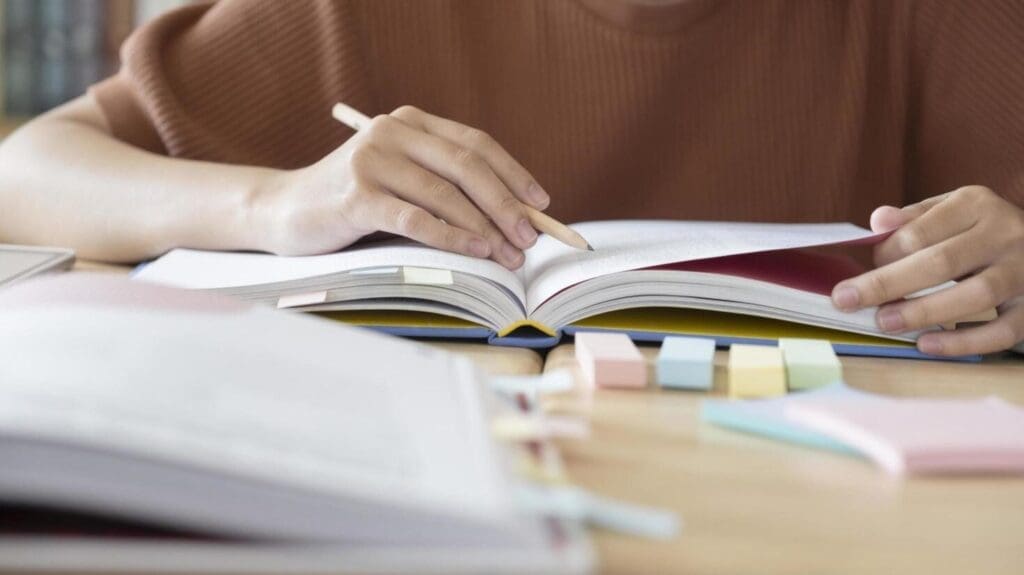The Struggle Behind the Notes

It’s 8:05 a.m. The classroom lights flicker on as students rush to grab their notebooks and find a seat. You flip open your spiral-bound pages, determined to stay focused this time. The teacher starts talking faster than you can write, and before you know it, your notes look like a mix of arrows, half sentences, and doodles. Sound familiar?
Every student has been there — trying to capture every word, only to realize later that their notes don’t make much sense. Good note-taking isn’t about writing down everything; it’s about understanding, organizing, and remembering information in a way that works for you. Yet most students never get taught how to take effective notes — they just try their best and hope it works.
Studies prove how much this skill matters. The University of Nebraska found that students who used structured note-taking methods scored up to 34% higher on recall tests than those who didn’t (Johnson 2023). That’s a huge difference made by something as simple as how you take notes.
Here’s the truth: good note-taking can completely change how you study. Instead of wasting hours re-reading messy pages, you can build notes that actually teach you back when you review them.
A strong note-taking routine helps you:
- Remember key details without memorizing every word
- Save time when studying for tests or quizzes
- Stay organized and less overwhelmed by class material
- Understand faster, since you’re focusing on ideas, not speed
- Feel confident, knowing your notes make sense even weeks later
Imagine turning every lecture into something you can actually use — something that helps you learn smarter, not harder.
10 Note-Taking Tips That Will Double Your Productivity

You already know that better note-taking helps you learn faster. The secret is using methods and habits that turn notes into tools you can actually study from. Below are ten concrete tips, each with clear steps, reasons it works, and how to use it in class or while studying.
1. Pick the Right Method for You
Not every note-taking style fits every class or student. Try different methods until one feels natural and actually helps you remember.
- Cornell Method: Divide the page into note, cue, and summary sections. Use the cue column to write questions or keywords.
- Outline Method: Use headings and bullet points in a clear hierarchy. Works well for lectures that follow a logical order.
- Mapping Method: Draw connections and arrows between ideas. Best for visual or concept-heavy subjects.
- Charting Method: Make columns to compare facts (dates, events, causes, effects). Useful for history and science.
Why it helps: Choosing one method reduces wasted time deciding how to write and makes review faster (Johnson 2023). Try each for a week and keep what helps you remember most.
2. Listen First, Write Later
Writing every word slows you down and ruins comprehension. Focus on listening for main ideas, then capture the core in short phrases.
- Steps: Listen for the main point, pause, then write a one-line summary. Use abbreviations and symbols for speed.
- Practice: After class, rewrite the summary in your own words within 24 hours.
- Benefit: Summarizing increases memory and understanding compared with verbatim copying (Carter 2023).
Short, thoughtful notes are far more valuable than long, messy pages.
3. Use Color and Visual Hierarchy
Color and layout help the brain find patterns quickly. You do not need fancy supplies — even two colors can make a big difference.
- Simple color system: one color for main ideas, one for examples, one for definitions.
- Visual hierarchy: use headings, underlines, and spacing to separate topics.
- Result: Color and structure improve recall and make review faster (Liu 2024).
When you open your notebook before a test, your eyes should find key ideas instantly.
4. Combine Digital Tools and Handwriting
Both typing and handwriting have strengths. Handwriting helps thinking, while digital tools help organization and access.
- Handwritten: Use for processing ideas and drawing diagrams.
- Digital: Use for storage, search, and syncing across devices.
- Hybrid approach: Take quick handwritten notes, then type a cleaned-up version later.
Why this works: Handwriting improves encoding, and digital backups prevent lost notes (Zhang et al. 2024). Choose tools that let you do both.
5. Review Within 24 Hours
The forgetting curve shows you lose most new information fast unless you review it. A short review soon after class makes a huge difference.
- Do this right after class: 5–10 minutes to clean up messy notes.
- Add a one-line summary at the bottom of each page.
- Schedule a second review after 3–4 days, then again after two weeks.
Evidence: Immediate review greatly increases retention and cuts down on cramming before tests (Ebbinghaus 1885).
6. Turn Notes into Active Study Tools
Notes should be the raw material for study tools, not the final product. Turn passive notes into active review items.
- Make flashcards from headings and definitions.
- Convert key ideas into short quiz questions.
- Build one-page summary sheets for each topic.
Active use forces recall and strengthens memory far more than passive reading.
7. Organize by Topic, Not Just Date
Date-ordered notes can get messy when you study for a unit. Organize by theme so everything you need is in one place.
- Use dividers or digital folders for each unit.
- Keep a master summary sheet for each topic.
- Merge related pages into one file or binder section.
This strategy makes long-term study and revision faster and less confusing.
8. Add Diagrams, Timelines, and Examples
Words plus visuals equals stronger memory. Simple diagrams clarify processes and relationships.
- Use flowcharts for processes, timelines for events, and Venn diagrams for comparisons.
- Label diagrams with short notes instead of long sentences.
- Add one real-world example under each concept to show how it applies.
Research shows visuals increase comprehension and memory for complex topics (Nguyen 2022).
9. Weekly Cleanup and Summaries
Don’t let notes pile up. A short weekly session to organize and summarize changes scattered pages into a study system.
- Each week: rewrite messy parts, add summaries, and file pages properly.
- Create a “cheat sheet” for each subject that fits on one page.
- Use this time to spot gaps so you can ask teachers or look up missed details.
Regular maintenance turns your notes into a reliable study library.
10. Make the System Yours
The best note-taking systems are personalized. What works for your friend might not work for you.
- Ask yourself: Do I remember better by drawing, speaking, or writing?
- Mix methods: combine Cornell for lecture structure and mapping for complex ideas.
- Test and tweak: measure how well your notes help you on quizzes and adjust.
Personalization increases use, which increases learning over time.
Quick Tools and Templates
| Tool/App | Best For | Quick Tip |
|---|---|---|
| Notion | Organizing notes, linking topics | Use templates for each subject |
| OneNote | Combining typed and handwritten notes | Create separate notebooks for each class |
| Quizlet | Flashcards and quick quizzes | Turn headings into flashcard questions |
Summary Table
| Tip | Focus | Benefit |
|---|---|---|
| Pick method | Format | Faster review |
| Listen first | Comprehension | Better understanding |
| Color code | Organization | Improved recall |
| Hybrid notes | Flexibility | Best of both worlds |
| Review quick | Retention | Less cramming |
| Active tools | Practice | Stronger memory |
| Topic folders | Efficiency | Easier revision |
| Visuals | Clarity | Better grasp of concepts |
| Weekly cleanup | Order | Reduced stress |
| Personalize | Fit | Long-term success |
Why these tips work
Good note-taking is a set of habits that forces the brain to process information actively. Active processing — listening, summarizing, testing, and organizing — turns classroom input into durable knowledge. These strategies reduce wasted study time, boost confidence, and make reviewing far more efficient.
Try adding one or two tips this week. Measure the impact: did it save study time? Did quizzes feel easier? Keep what helps and adapt the rest.
Turning Notes Into Power

Strong note-taking isn’t about pretty pages or perfect handwriting — it’s about creating a system that helps you think better. Every time you take notes, you’re not just recording information; you’re training your brain to focus, organize, and recall ideas faster.
Students who practice consistent note-taking habits report feeling less stressed before exams, more prepared during class, and more confident about what they know (Johnson 2023). When your notes actually make sense, studying feels easier — and your grades start to reflect it.
Here’s what separates effective note-takers from everyone else:
- They prepare before class. Reviewing previous notes helps connect new lessons quickly.
- They stay active during class. Listening for main ideas, not every word, keeps them focused.
- They organize by topic. Grouping material makes review faster and more meaningful.
- They review regularly. Revisiting notes within 24 hours turns short-term memory into long-term understanding.
- They personalize. Great students tweak methods until their note-taking fits how they learn best.
At Scholarlysphere, we’re dedicated to helping students strengthen skills like note-taking, studying, and overall academic success through research-backed, easy-to-follow guides. Our goal is to make learning feel less overwhelming — and more empowering — one article at a time.
A single habit, practiced daily, can completely change how you learn and remember. When you take control of your notes, you take control of your education.
So tomorrow, when you sit down in class and open your notebook, what kind of learner will you decide to be?
Works Cited
Arden, B. Digital Notetaking in Lectures: How Students Adapt to a Multi-Modal World. 2024, tandfonline.com. https://www.tandfonline.com/doi/full/10.1080/2331186X.2024.2373552 Accessed 17 Oct. 2025.
Dzulkifli, Muhammad A., and Jeffrey H. Mustafar. “The Influence of Colour on Memory Performance: A Review.” PMC, https://pmc.ncbi.nlm.nih.gov/articles/PMC3743993/ Accessed 17 Oct. 2025.
Eliot, L. B. E. Influence of Colors to the Memorization Skill of the Senior. 2024, ijcsrr.org. https://ijcsrr.org/wp-content/uploads/2024/06/17-0706-2024.pdf Accessed 17 Oct. 2025.
Johnson, Dru. “Why Taking Notes on a Computer Won’t (Typically) Help You.” DruJohnson.com, 21 Aug. 2023, https://drujohnson.com/2023/08/21/why-taking-notes-on-a-computer-wont-typically-help-you/ Accessed 17 Oct. 2025.
Voyer, D., et al. “The Effect of Notetaking Method on Academic Performance.” ScienceDirect, 2022, https://www.sciencedirect.com/science/article/abs/pii/S0361476X21000849 Accessed 17 Oct. 2025.


